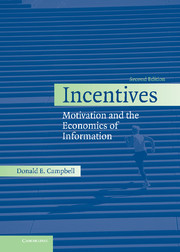Book contents
- Frontmatter
- Contents
- Preface to the Second Edition
- 1 Equilibrium, Efficiency, and Asymmetric Information
- 2 Basic Models and Tools
- 3 Hidden Action
- 4 Corporate Governance
- 5 Hidden Characteristics
- 6 Auctions
- 7 Voting and Preference Revelation
- 8 Public Goods and Preference Revelation
- 9 Matching
- 10 General Competitive Equilibrium
- References
- Author Index
- Subject Index
8 - Public Goods and Preference Revelation
- Frontmatter
- Contents
- Preface to the Second Edition
- 1 Equilibrium, Efficiency, and Asymmetric Information
- 2 Basic Models and Tools
- 3 Hidden Action
- 4 Corporate Governance
- 5 Hidden Characteristics
- 6 Auctions
- 7 Voting and Preference Revelation
- 8 Public Goods and Preference Revelation
- 9 Matching
- 10 General Competitive Equilibrium
- References
- Author Index
- Subject Index
Summary
This chapter continues the exploration of hidden characteristic problems, with attention confined to the problem of preference revelation in the presence of a good that can be consumed jointly and simultaneously by the whole community—a fireworks display, for instance.
Agent A's action generates a positive spillover if some other agent B benefits as a result of that action. For example, if A removes weeds from A's own property, then neighbor B's grass will have fewer weeds because one source of seed has been eliminated. In this case, most of the benefit of A's effort is reaped by A, so we say that the spillover is incomplete. However, if C produces a fireworks display then everyone else in town will have just as good a view of it as C. The spillover is complete in that case. When the agent creating the spillover benefit is not compensated for the positive effect on the welfare of others, we refer to it as an externality. Important examples include the containment of a virulent disease by a health organization, the retardation of global warming or ozone depletion by international treaty, and publication of information concerning public safety.
Our aim is to provide the individual decision maker with incentive to consider the benefit that others derive from his or her actions. The decision maker can be a single individual or household, or a region within a country, or even a country itself.
- Type
- Chapter
- Information
- IncentivesMotivation and the Economics of Information, pp. 420 - 466Publisher: Cambridge University PressPrint publication year: 2006

